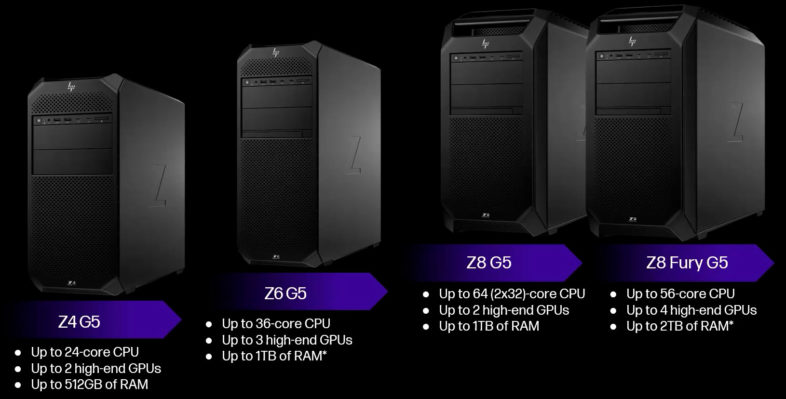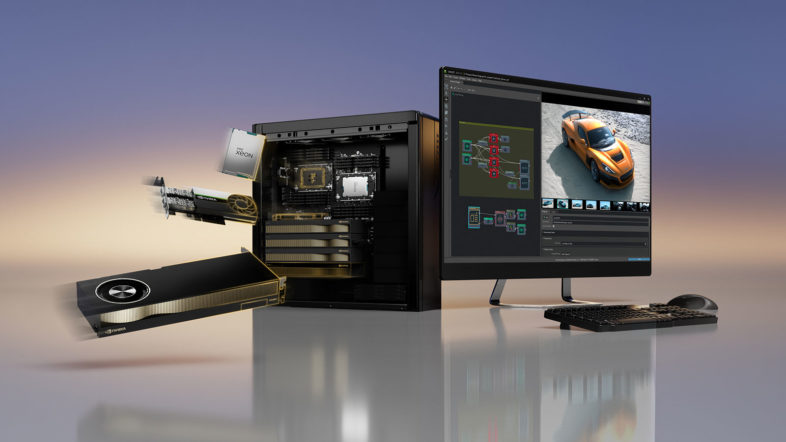After many years without a significant update to most major workstation offerings, we are finally seeing new technology about to hit the workstation market. Intel’s recently released Sapphire Rapids server CPU technology, built on the ‘Intel 7’ process, forms the basis for their new Sapphire Rapids workstation platform. These processors come in two tiers, the Xeon W-2400 processors with quad channel DDR5 memory and up to 24 cores, and the Xeon W-3400 processors, with 8-channel DDR5 memory and up to 56 cores.
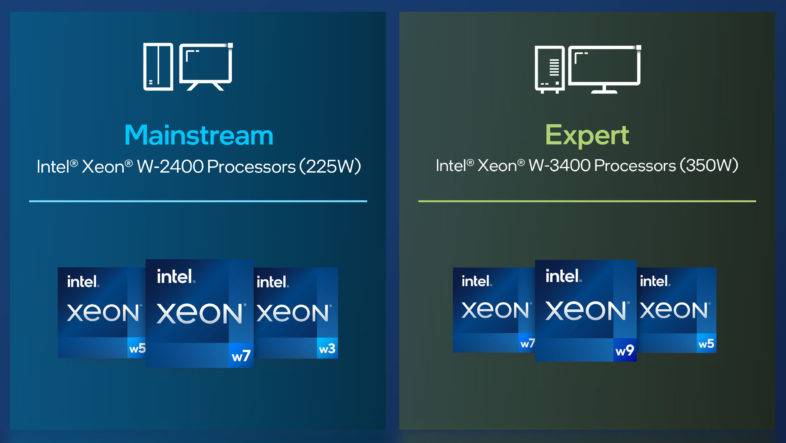
In my opinion, the Xeon W-2400 tier of processors is the most significant news, as it replaces the Core-X line of products, on the old X299 platform, which was originally introduced in 2017. 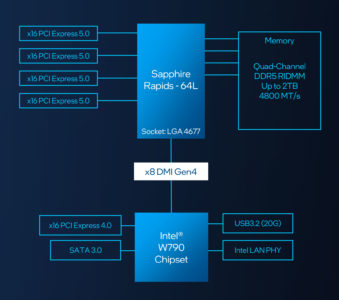 It maintains the existing quad channel interface of the HEDT class systems, but with the newer DDR5 technology. And it upgrades the PCIe interface 2 steps from 3.0 to 5.0, quadrupling the bandwidth per lane, and increasing the lane count to 64 total. With AMD retiring their standard Threadripper line last year, this gives Intel the decisive upper hand in the HEDT market for the foreseeable future. The closest AMD competition is the Ryzen CPUs, which have up to 16 cores, but are limited to dual channel memory, and much less PCIe bandwidth. While Intel’s 13th generation ‘Raptor Lake’ consumer CPUs also have 24 cores, they only have 8 ‘performance cores,’ while the rest are smaller ‘efficiency cores.’ The 24 cores in the W7-2495X are all ‘performance cores,’ giving it three times as many as the 13900K, for a roughly corresponding tripling in price. The prices throughout the new lineup are relatively linearly consistent, at about $80-90/core. I feel like it used to be cheaper to buy in bulk a decade ago, in that a quad core CPU didn’t cost twice as much as a dual core, but then recently the higher core counts came at a steep premium. So I suppose linear scaling of price and core count seems fair.
It maintains the existing quad channel interface of the HEDT class systems, but with the newer DDR5 technology. And it upgrades the PCIe interface 2 steps from 3.0 to 5.0, quadrupling the bandwidth per lane, and increasing the lane count to 64 total. With AMD retiring their standard Threadripper line last year, this gives Intel the decisive upper hand in the HEDT market for the foreseeable future. The closest AMD competition is the Ryzen CPUs, which have up to 16 cores, but are limited to dual channel memory, and much less PCIe bandwidth. While Intel’s 13th generation ‘Raptor Lake’ consumer CPUs also have 24 cores, they only have 8 ‘performance cores,’ while the rest are smaller ‘efficiency cores.’ The 24 cores in the W7-2495X are all ‘performance cores,’ giving it three times as many as the 13900K, for a roughly corresponding tripling in price. The prices throughout the new lineup are relatively linearly consistent, at about $80-90/core. I feel like it used to be cheaper to buy in bulk a decade ago, in that a quad core CPU didn’t cost twice as much as a dual core, but then recently the higher core counts came at a steep premium. So I suppose linear scaling of price and core count seems fair.
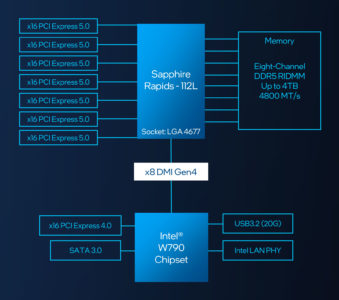 The Xeon W-3400 processors are also a welcome step forward, but with an intermediate W-3300 series released just over a year ago, this class of system has had more current options available, making this a smaller jump from existing offerings. I reviewed Boxx’s Apexx Matterhorn system just over a year ago, based on the Xeon W-3300 ‘Ice Lake’ processors. The max core count with the new Xeon W-3400 chips jumps from 38 to 56, and the DDR and PCIe bandwidths both bump up to 5th generation. And the PCIe lane count increases from 64 to 112. These products directly compete with AMDs Threadripper Pro architecture, which supports 8 channels of DDR4 memory, and 128 lanes of PCIe 4.0 bandwidth. We will have to wait until we have performance reviews before we will know how the new 3400 series chips compare to existing choices in the market. But Intel did provide some relative performance estimates compared to previous generations, and the biggest gains are anticipated in the area of 3D, as that is one of the most multithreaded and CPU limited tasks. Editing is more I/O based, so the gains for those users will be more about system bandwidth and component support than render time.
The Xeon W-3400 processors are also a welcome step forward, but with an intermediate W-3300 series released just over a year ago, this class of system has had more current options available, making this a smaller jump from existing offerings. I reviewed Boxx’s Apexx Matterhorn system just over a year ago, based on the Xeon W-3300 ‘Ice Lake’ processors. The max core count with the new Xeon W-3400 chips jumps from 38 to 56, and the DDR and PCIe bandwidths both bump up to 5th generation. And the PCIe lane count increases from 64 to 112. These products directly compete with AMDs Threadripper Pro architecture, which supports 8 channels of DDR4 memory, and 128 lanes of PCIe 4.0 bandwidth. We will have to wait until we have performance reviews before we will know how the new 3400 series chips compare to existing choices in the market. But Intel did provide some relative performance estimates compared to previous generations, and the biggest gains are anticipated in the area of 3D, as that is one of the most multithreaded and CPU limited tasks. Editing is more I/O based, so the gains for those users will be more about system bandwidth and component support than render time. 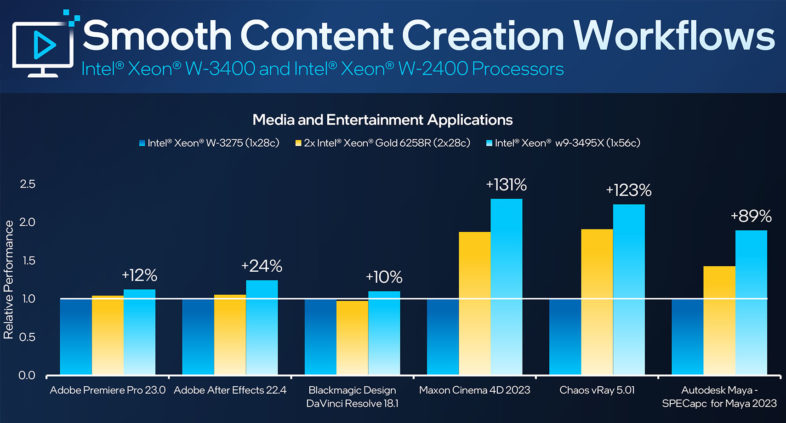
The W-3400 CPUs are priced at about $100/core, slightly more expensive due to the multi-chip packaging, and the extra memory and system bandwidth. While there is a 56-core model, the W9-3495X with a 350W power envelope, that will not be available via retail. DIY builders will be limited to 36 cores in the W9-3475X, rated at 300W. I recall there were performance issues in certain applications when exceeding 32 cores with Ice Lake (W-3300) systems, leading to better performance with the 32 core model than the 38 core option. So it will be interesting to see how these CPUs that exceed 32 cores fare in different applications this time around.
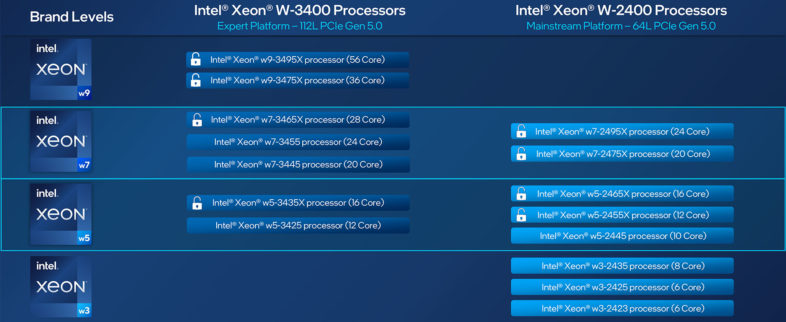 Both tiers are now divided into performance levels: W3, W5, W7, & W9. These roughly correspond to the existing ‘Core’ line-up’s i3, i,5, i7, & i9 which many users will be familiar with on the consumer side of the market. W3 is single digit core counts and DDR5-4400 memory. Moving to a W5 class chip jumps to double digit cores and DDR5-4800 memory. W7 indicates core counts in the 20’s, and W9 is for chips above that.
Both tiers are now divided into performance levels: W3, W5, W7, & W9. These roughly correspond to the existing ‘Core’ line-up’s i3, i,5, i7, & i9 which many users will be familiar with on the consumer side of the market. W3 is single digit core counts and DDR5-4400 memory. Moving to a W5 class chip jumps to double digit cores and DDR5-4800 memory. W7 indicates core counts in the 20’s, and W9 is for chips above that.
 All of the new Sapphire Rapids CPUs will fit into the same LGA 4677 socket, on new W790 chipset motherboards. The chipset supports up to 16 DIMM channels, and 8 SATA ports for hard drives, as well as 2.5GbE and WiFi 6E. While the 2400 CPUs are based on a monolithic die, the higher core counts on the 3400 CPUs are made possible by linking together multiple separate chiplets with Intel’s new Embedded Multi-Die Interconnect Bridge (EMIB). This process should allow scaling to even higher core counts in single large sockets in the future. One feature that is ‘missing’ from these new processors (and nearly all existing Xeons) is Intel’s QuickSync media accelerator. This is what allows hardware encode and decode of HEVC and other video codecs on consumer systems, but I am told that these CPUs are fast enough to do that with dedicated accelerators, and workstations usually have discrete GPUs, which also offer similar hardware acceleration now in many applications. So while that could have been a significant consideration for video editors two years ago, it shouldn’t make much difference now, especially when paired to a modern GPU.
All of the new Sapphire Rapids CPUs will fit into the same LGA 4677 socket, on new W790 chipset motherboards. The chipset supports up to 16 DIMM channels, and 8 SATA ports for hard drives, as well as 2.5GbE and WiFi 6E. While the 2400 CPUs are based on a monolithic die, the higher core counts on the 3400 CPUs are made possible by linking together multiple separate chiplets with Intel’s new Embedded Multi-Die Interconnect Bridge (EMIB). This process should allow scaling to even higher core counts in single large sockets in the future. One feature that is ‘missing’ from these new processors (and nearly all existing Xeons) is Intel’s QuickSync media accelerator. This is what allows hardware encode and decode of HEVC and other video codecs on consumer systems, but I am told that these CPUs are fast enough to do that with dedicated accelerators, and workstations usually have discrete GPUs, which also offer similar hardware acceleration now in many applications. So while that could have been a significant consideration for video editors two years ago, it shouldn’t make much difference now, especially when paired to a modern GPU.
Some of the first systems to use these new technologies are HP’s soon to be refreshed ‘Z Workstation’ systems. The Z4 Gen5 will be based on the 2400 series CPUs, offering up to 24 CPU Cores, 512GB RAM, and up to 2 full sized GPUs. This is a serious step up from the existing peak of 18 cores, and 44 PCIe 3.0 lanes. The Z6 line is getting a big change in that instead of being based on the server level Scalable Xeon CPUs, with support for a second CPU socket, the Z6 is now based on the single socket 3400 architecture. The Z8 Fury also has a similar single socket architecture, in a move I predicted last year, away from dual socket systems. There will also be a ‘traditional’ Z8 G5 variant with dual sockets, presumably based on the Sapphire Rapids dual socket server architecture, for those users who are convinced they need dual socket performance. But I expect that to be a rapidly diminishing number of customers, as culture catches up with technology. (Dual socket workstations will no longer be a status symbol when there are 100+ core CPUs in single socket systems.) In this case the “Fury” variant is clearly the top option, even with a single socket, supporting twice the RAM and GPU expansion. It also offers a unique dual power supply system, that can be used redundantly for uninterrupted operation, or in aggregate mode, to support high power draw configurations, like quad GPUs.
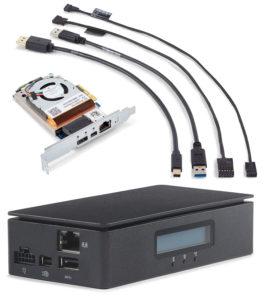 HP advertises that the systems are optimized for Windows 11 Pro for Workstations, but the underlying hardware from Intel should fully support Windows 10 as well. The new HP systems will all have support for Thunderbolt4 and the option of adding dual 10GbE interfaces. They will also fully support HP’s newest remote administration hardware, the HP Anywhere Remote System Controller. Available as either a PCIe card or an external box, it allows remote system control, out of band access, full control of system power, the BIOS, and other deep system access. This should help larger organizations better manage the workstations being used by their remote workers, similar in some ways to how they manage their servers. The new hardware products will be compatible with older (and even non-HP) systems, but with a sub-set of functions, as its access to the system won’t be as deep.
HP advertises that the systems are optimized for Windows 11 Pro for Workstations, but the underlying hardware from Intel should fully support Windows 10 as well. The new HP systems will all have support for Thunderbolt4 and the option of adding dual 10GbE interfaces. They will also fully support HP’s newest remote administration hardware, the HP Anywhere Remote System Controller. Available as either a PCIe card or an external box, it allows remote system control, out of band access, full control of system power, the BIOS, and other deep system access. This should help larger organizations better manage the workstations being used by their remote workers, similar in some ways to how they manage their servers. The new hardware products will be compatible with older (and even non-HP) systems, but with a sub-set of functions, as its access to the system won’t be as deep.
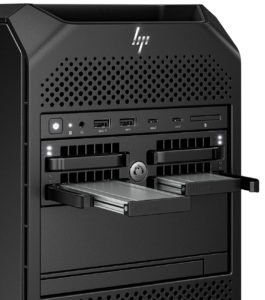 Another new feature of HP’s workstations, is their new option for front mounted hot-swappable M.2 based NVMe drives. With up to 4 lockable bays, it should a vast amount of high speed media storage, assuming money is no object. I do find it amusing that ‘sneaker-net’ is still a viable approach in certain cases in the modern world, although HP pointed out that the other use case for removable drives is locking up your data in a safe at night. Admittedly, there is the potential for transfer workflows, getting data from a remote shooting set, but those cases are becoming less frequent as the world become more connected. At this point Starlink should allow real-time dailies transfer from nearly anywhere in the world. But Terabytes of source data get generated on set now days, and will eventually need to make it back to media servers, so removable SSDs can offer a convenient way to do that.
Another new feature of HP’s workstations, is their new option for front mounted hot-swappable M.2 based NVMe drives. With up to 4 lockable bays, it should a vast amount of high speed media storage, assuming money is no object. I do find it amusing that ‘sneaker-net’ is still a viable approach in certain cases in the modern world, although HP pointed out that the other use case for removable drives is locking up your data in a safe at night. Admittedly, there is the potential for transfer workflows, getting data from a remote shooting set, but those cases are becoming less frequent as the world become more connected. At this point Starlink should allow real-time dailies transfer from nearly anywhere in the world. But Terabytes of source data get generated on set now days, and will eventually need to make it back to media servers, so removable SSDs can offer a convenient way to do that.
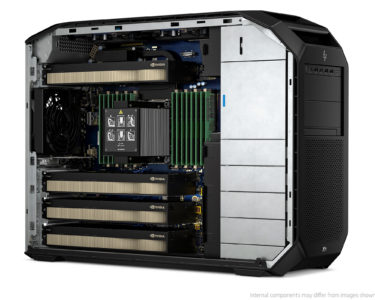 For most users, the extra PCIe bandwidth is going to be primarily used by NVMe storage, and GPU processing. These new systems support more GPUs than previous generations, when dual graphics cards where considered the upper limit for most users. So while consumer GPU usage is going the way of CPU sockets, consolidating to single powerful products with the demise of Crossfire and SLI, professional users needing more than 2 GPUs is much more common. The new HP Z8 systems support up to 4 full sized GPUs, but other vendors will surely offer solutions supporting even more GPUs than that, for smaller market segments.
For most users, the extra PCIe bandwidth is going to be primarily used by NVMe storage, and GPU processing. These new systems support more GPUs than previous generations, when dual graphics cards where considered the upper limit for most users. So while consumer GPU usage is going the way of CPU sockets, consolidating to single powerful products with the demise of Crossfire and SLI, professional users needing more than 2 GPUs is much more common. The new HP Z8 systems support up to 4 full sized GPUs, but other vendors will surely offer solutions supporting even more GPUs than that, for smaller market segments.
One or more of NVidia’s new Ada based RTX6000 cards will be the highest end GPU of choice for most power users, but a variety of more budget friendly Ampere options are also available, as well as some AMD based options. And systems can also be configured with NVidia’s ConnectX-6 SmartNICs for improved networking and collaboration support over 25/50GbE.
 I have been waiting for the successor to the X299 platform for a long time. I had to replace my own dual Xeon system last summer, and went with an Alder Lake solution, because I couldn’t imagine stepping back to PCIe 3.0 SSDs after experiencing smooth uncompressed 8K playback. And admittedly that consumer system meets most of my current needs, but a W-2400 based system would have future proofed me for a long time to come. So I expect that this new architecture will provide a welcome performance boost to many users who have been waiting for faster workstations to become available. I look forward to seeing them hit the market two months from now.
I have been waiting for the successor to the X299 platform for a long time. I had to replace my own dual Xeon system last summer, and went with an Alder Lake solution, because I couldn’t imagine stepping back to PCIe 3.0 SSDs after experiencing smooth uncompressed 8K playback. And admittedly that consumer system meets most of my current needs, but a W-2400 based system would have future proofed me for a long time to come. So I expect that this new architecture will provide a welcome performance boost to many users who have been waiting for faster workstations to become available. I look forward to seeing them hit the market two months from now.

